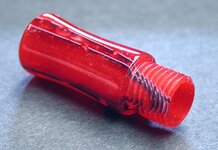soligen
Member
On my first kitless pens i posted a week or so ago, it took me several attempts to make a good nib coupler (I used aluminum)
I finally worked it out and got a good fitting, true coupler. However this is a small fit & finish issue I would like opinions on.
I stopped the threads just a tad (myabe 1/32) short of the barren so that I had a square shounder on the coupler for pressing in. However, I can see marks in the last thread where I stopped the die. It just looks like little divots in each place where the die stopped citting.
Other than this, the threads were very smooth, and all i did was buff them and got a good shine.
So the question. I'm new to cutting threads. Can anyone share a technique to avoid the little divots, or is this an unavoidable aspect of using a die?
Thanks
I finally worked it out and got a good fitting, true coupler. However this is a small fit & finish issue I would like opinions on.
I stopped the threads just a tad (myabe 1/32) short of the barren so that I had a square shounder on the coupler for pressing in. However, I can see marks in the last thread where I stopped the die. It just looks like little divots in each place where the die stopped citting.
Other than this, the threads were very smooth, and all i did was buff them and got a good shine.
So the question. I'm new to cutting threads. Can anyone share a technique to avoid the little divots, or is this an unavoidable aspect of using a die?
Thanks

